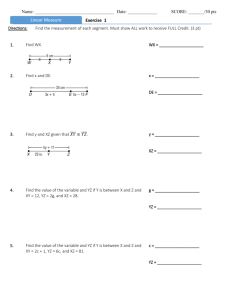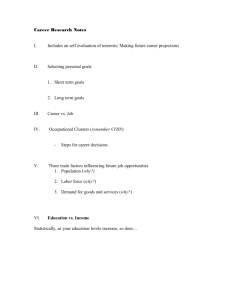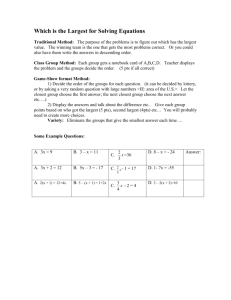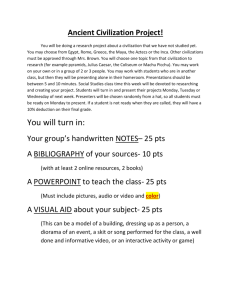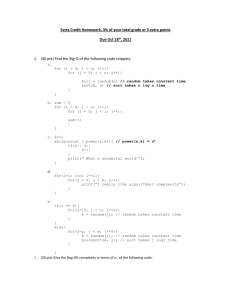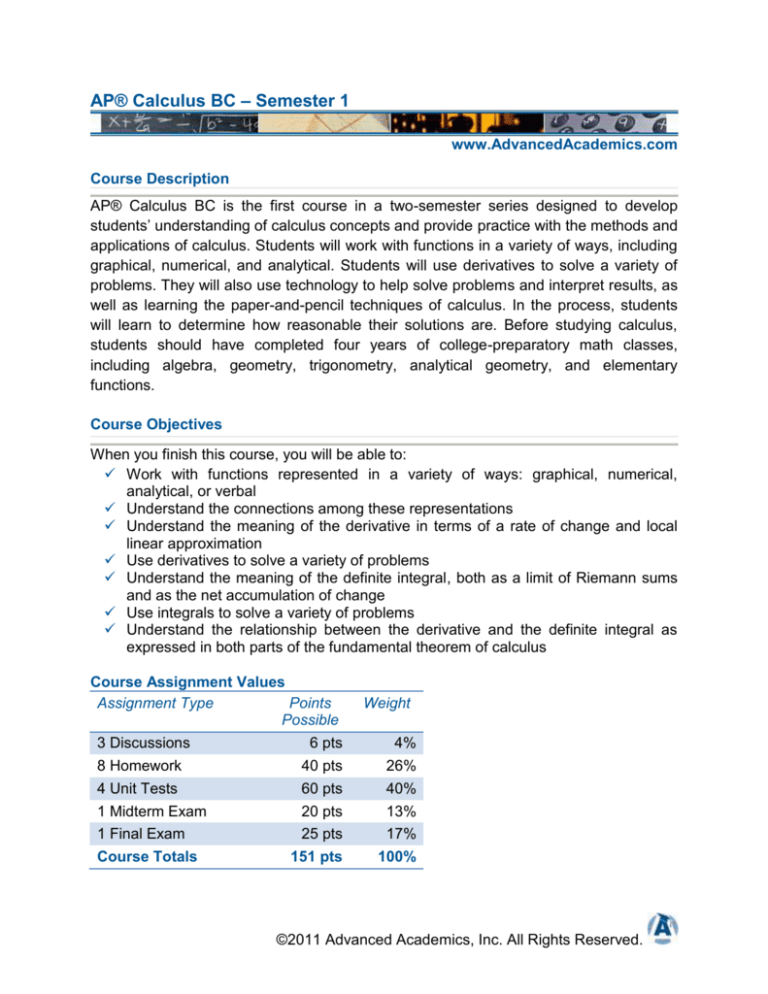
AP® Calculus BC – Semester 1
www.AdvancedAcademics.com
Course Description
AP® Calculus BC is the first course in a two-semester series designed to develop
students’ understanding of calculus concepts and provide practice with the methods and
applications of calculus. Students will work with functions in a variety of ways, including
graphical, numerical, and analytical. Students will use derivatives to solve a variety of
problems. They will also use technology to help solve problems and interpret results, as
well as learning the paper-and-pencil techniques of calculus. In the process, students
will learn to determine how reasonable their solutions are. Before studying calculus,
students should have completed four years of college-preparatory math classes,
including algebra, geometry, trigonometry, analytical geometry, and elementary
functions.
Course Objectives
When you finish this course, you will be able to:
Work with functions represented in a variety of ways: graphical, numerical,
analytical, or verbal
Understand the connections among these representations
Understand the meaning of the derivative in terms of a rate of change and local
linear approximation
Use derivatives to solve a variety of problems
Understand the meaning of the definite integral, both as a limit of Riemann sums
and as the net accumulation of change
Use integrals to solve a variety of problems
Understand the relationship between the derivative and the definite integral as
expressed in both parts of the fundamental theorem of calculus
Course Assignment Values
Assignment Type
Points
Possible
Weight
3 Discussions
6 pts
4%
8 Homework
40 pts
26%
4 Unit Tests
60 pts
40%
1 Midterm Exam
1 Final Exam
20 pts
25 pts
13%
17%
151 pts
100%
Course Totals
©2011 Advanced Academics, Inc. All Rights Reserved.
Suggested Course Schedule
The suggested time frame shown below is based on learning sessions. A learning
session is a 45-minute period of time. This course should take approximately 90
learning sessions to complete, but this schedule is just a suggestion. You may work on
each unit at your own pace, completing as many learning sessions as you’d like in one
sitting. However, keep in mind that you must finish the entire course within the time
specified by your school district.
Learning
Session
1-23
Content Covered
Unit 1: Functions and Graphs
Lesson 1: Functions and Function Notation
Topic 1: Definition of a Function
Topic 2: Vertical Line Test
Topic 3: Function Notation
Topic 4: Finding Input and Output Values
Topic 5: Domain and Range
Lesson 2: Absolute Value and Piecewise Defined Functions
Topic 1: Piecewise Defined Functions
Topic 2: The Absolute Value Function
Topic 3: Solving Equations Involving Absolute Values
Lesson 3: Inequalities
Topic 1: Solving Inequalities
Topic 2: Solving Inequalities Involving Absolute Values
Lesson 4: Composition and Combination Functions
Topic 1: Composition Functions
Topic 2: Inverse Functions
Topic 3: Non-invertible Functions
Lesson 5: Exponential and Logarithmic Functions
Topic 1: The Family Exponential Functions
Topic 2: The Number e
Topic 3: Logarithmic Functions
Topic 4: Solving Exponential and Logarithmic Functions
Topic 5: Changing the Base of Logarithmic Functions
Lesson 6: Transformation of Functions
Topic 1: Horizontal and Vertical Shifts
Topic 2: Reflections and Symmetry
Topic 3: Vertical Stretches and Compressions
Topic 4: Horizontal Stretches and Compressions
Lesson 7: Trigonometric Functions
©2011 Advanced Academics, Inc. All Rights Reserved.
Topic 1: Radians and Arc Length
Topic 2: The Sine and Cosine Functions
Topic 3: Other Trigonometric Functions
Topic 4: Inverse Trigonometric Functions
Topic 5: Trigonometric Identities
Lesson 8: Polynomial and Rational Functions
Topic 1: Variations
Topic 2: Power Functions
Topic 3: Polynomial Functions
Topic 4: Rational Functions
Lesson 9: Vectors and Vector-Valued Functions
Topic 1: Vectors
Topic 2: Components of a Vector
Topic 3: Addition, Subtraction, and Scalar Multiplication
Topic 4: The Zero and Unit Vectors
Lesson 10: Polar Coordinates and Graphs
Topic 1: Polar Coordinates
Topic 2: Coordinate Conversion
Topic 3: Polar Graphs
Topic 4: Special Polar Graphs
Lesson 11: Parametric Equations and Conic Sections
Topic 1: Parametric Equations
Topic 2: Eliminating and Parameter
Topic 3: Finding Parametric Equations
24-46
In this unit, there will be:
2 Assignments
10 pts
1 Unit Test
15 pts
Unit 2: Limits and Continuity
Lesson 12: Intuitive Definition of a Limit
Topic 1: Definition
Topic 2: Using Tables and Graphs to Find Limits
Topic 3: Application: Using Limits to Find Velocity
Lesson 13: Algebraic Techniques for Finding Limits
Topic 1: Calculating Limits Using Limit Laws
Topic 2: Direct Substitution Property
Topic 3: Indeterminate Forms
Lesson 14: One-Sided Limits
Topic 1: Definition of One-Sided Limits
Topic 2: Finding One-Sided Limits
©2011 Advanced Academics, Inc. All Rights Reserved.
Topic 3: Existence of Limits
Lesson 15: Infinite Limits
Topic 1: Definition of Infinite Limits
Topic 2: Vertical Asymptotes
Lesson 16: Limits of Infinity
Topic 1: End-Behavior of Function and Horizontal Asymptotes
Topic 2: Limit Laws of Infinite Limits
Topic 3: Oblique Asymptotes
Lesson 17: Limits of Special Trigonometric Functions
Topic 1: Special Limits Involving the Sine Function
Topic 2: Special Limits Involving the Cosine Function
Topic 3: Special limits Involving the Tangent Function
Lesson 18: Continuity
Topic 1: Continuity at a Point
Topic 2: Continuity on a Closed Interval
Topic 3: Continuity on an Open Interval
Topic 4: Intermediate Value Theorem
47-70
In this unit, there will be:
2 Assignments
10 pts
1 Unit Test
15 pts
AP® Calculus BC – Semester 1 20 pts
Midterm Exam
Unit 3: Derivatives
Lesson 19: Definition of the Derivative
Topic 1: The Derivative as the Slope of a Tangent
Topic 2: The Derivative as the Rate of Change
Topic 3: The Derivative as a Function
Lesson 20: Differentiation Rules
Topic 1: Constant Rule and Constant Multiple Rule
Topic 2: Power Rule
Topic 3: Sum Rule and Difference Rule
Topic 4: Product Rule
Topic 5: Quotient Rule
Topic 6: Trigonometric Rules
Lesson 21: The Chain Rule
Topic 1: Chain Rule Definition
Topic 2: The Chain Rule with Other Rules
Topic 3: Higher-Order Derivatives
Lesson 22: Derivatives of Exponential Functions
©2011 Advanced Academics, Inc. All Rights Reserved.
Topic 1: Exponential Rule
Topic 2: Base-e Exponentials Rule
Lesson 23: Derivatives of Logarithmic Functions
Topic 1: Natural Logarithmic Rule
Topic 2: General Logarithmic Rule
Lesson 24: Derivatives of Inverse Functions
Topic 1: Inverse Trig Rule
Topic 2: Derivatives of Inverses
Lesson 25: Differentiability and Continuity
Topic 1: Differentiability Implies Continuity
Topic 2: Non-Differentiable Functions
Lesson 26: Implicit Differentiation
Topic 1: Derivatives of Implicitly-Defined Functions
Lesson 27: Logarithmic Differentiation
Topic 1: Derivatives of Complicated Expressions
Lesson 28: Parametric Derivatives
Topic 1: Parametric Form of the Derivative
Topic 2: Parametric Form of the Second Derivative
Lesson 29: Differentiation with Polar Curves
Topic 1: Tangents to Polar Slopes
Lesson 30: Differentiation of Vector-Valued Functions
Topic 1: Limits and Continuity
Topic 2: Derivatives of Vector-Valued Functions
Topic 3: Differentiation Rules and Examples
71-90
In this unit, there will be:
1 Discussion
2 pts
2 Assignments
10 pts
1 Unit Test
15 pts
Unit 4: Application of the Derivative
Lesson 31: Tangent and Normal Lines
Topic 1: Tangent Lines
Topic 2: Normal Lines
Lesson 32: Position, Velocity, and Acceleration (PVA)
Topic 1: Position and Velocity
Topic 2: Acceleration
Lesson 33: Related Rates
Topic 1: Defining the Problem
Topic 2: Example Problems
Lesson 34: Relative Extrema and the First Derivative Test
©2011 Advanced Academics, Inc. All Rights Reserved.
Topic 1: Relative Extrema and Critical Numbers
Topic 2: Increasing and Decreasing Functions and First Derivative
Lesson 35: Concavity and the Second Derivative Test
Topic 1: Concavity
Topic 2: The Second Derivative Test
Lesson 36: Absolute Extrema and Optimization
Topic 1: Extreme Value Theorem
Topic 2: Sample Problem
Lesson 37: Rolle’s Rule and the Mean Value Theorem
Topic 1: Rolle’s Rule
Topic 2: Extreme Value Theorem
Lesson 38: Differentials
Topic 1: Linear Approximation
Topic 2: Differentials
Lesson 39: L’Hopital’s Rule
Topic 1: Indeterminate Forms and L’Hopital’s Rule
In this unit, there will be:
1 Discussion
2 pts
2 Assignments
10 pts
1 Unit Test
15 pts
AP® Calculus BC – Semester 1 27 pts
Final Discussion and Final
Exam
Privacy Policy
No member of the Advanced Academics staff is authorized to release student
information without the written permission of the student’s parent or legal guardian.
Names, images, and/or class work of Advanced Academics students will not be
published in print, video/film, or on our public website without written student and
guardian consent.
Disability Statement
If you have a disability or condition that may affect your ability to succeed in this course,
please contact your teacher. It’s important that you discuss the problem with him or her
so accommodations may be made to give you every opportunity to perform well. Your
teacher and virtual school program coordinators are committed to helping students with
disabilities succeed, and every request will be treated with respect and confidentiality.
©2011 Advanced Academics, Inc. All Rights Reserved.
Other Resources
TI-83 or similar graphing calculator
Course Texts and Readings
The following textbook is required for this online course.
Title: Calculus
Author: Stewart
Edition: 6
Publisher: Brooks Cole
Publication Date: June 11, 2007
ISBN-10: 0495011606
ISBN-13: 978-0495011606
©2011 Advanced Academics, Inc. All Rights Reserved.


